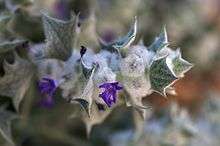Salvia funerea
| Salvia funerea | |
|---|---|
 | |
| in Titus Canyon, Death Valley | |
| Scientific classification | |
| Kingdom: | Plantae |
| (unranked): | Angiosperms |
| (unranked): | Eudicots |
| (unranked): | Asterids |
| Order: | Lamiales |
| Family: | Lamiaceae |
| Genus: | Salvia |
| Species: | S. funerea |
| Binomial name | |
| Salvia funerea | |
Salvia funerea, with the common names Death Valley sage, woolly sage, and funeral sage, is an intricately branched shrub associated with limestone soils in the Mojave Desert in California and Nevada.[1] It has an overall white appearance due to wooly hairs that cover the stems and leaves.[1]
Distribution
The plant can be found in dry washes and canyons: including on the western slopes of the Funeral Mountains, Black Mountains, and Granite Mountains, in Titus Canyon in the Grapevine Mountains, and in the northern Panamint Range.[1] Most populations are within Death Valley National Park, in Inyo County, California and Nye County, Nevada.
The specific epithet, "funerea", relates to where the plant was first found, in the Funeral Mountains along the California-Nevada border. It is closely related to Salvia greatae.[2]
Description
Salvia funerea is a shrub that produces many branches coated in white woolly fibers and may exceed a meter in height. The leaves are tipped with spines.
2-lipped flowers occur in clusters of three in each leaf axil. The tubular purple or blue corollas are between one and two centimeters long and are surrounded by calyces of spine-tipped sepals. The flowers on 1"-3" spikes are partially hidden by tufts of wool.[1]
References
- 1 2 3 4 Mojave Desert Wildflowers, Pam MacKay, 2nd ed., p 57
- ↑ Jaeger, Edmund C. (1940). Desert Wild Flowers. Stanford University Press. ISBN 978-0-8047-0365-9.
- Mojave Desert Wildflowers, Jon Mark Stewart, 1998, pg. 183
External links
- Jepson Manual Treatment of Salvia funerea
- USDA Plants Profile for Salvia funerea
- UC CalPhotos gallery of Salvia funerea
| Wikimedia Commons has media related to Salvia funerea. |